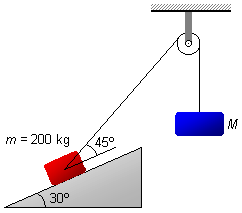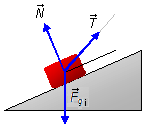Solved Problem on Static Equilibrium
advertisement
A body with a mass of 200 kg is kept in equilibrium on an inclined plane at an angle of 30° relative to
the horizontal by a rope that passes over a fixed pulley and supports another body with a mass M
at the other end. The rope makes a 45° angle with the inclined line of the plane. Determine:
a) The mass M;
b) The force exerted by the body against the plane.
a) The mass M;
b) The force exerted by the body against the plane.

Problem data:
- Mass of the body on the inclined plane: m=200 kg;
- Angle of the inclined plane with the horizontal: 30°;
- Angle of the rope with the inclined plane: 45°;
- Acceleration due to gravity: g=9.8 m/s2.
Drawing free-bodies diagrams, we have the forces acting on the blocks.
- Body of mass M (Figure 1):
- \( \vec T \): tension force in the rope;
- \( {\vec F}_{gM} \): gravitational force of the suspended body.

- Body of mass 200 kg (Figure 2):
- \( \vec T \): tension force in the rope;
- \( {\vec F}_{gi} \): gravitational force of the body on the inclined plane;
- \( \vec N \): normal reaction force of the plane on the block.

Solution:
Since the system is in equilibrium, the resultant of the forces acting on it is zero.
\[
\begin{gather}
\bbox[#99CCFF,10px]
{\sum \vec F=0} \tag{I}
\end{gather}
\]
- Body of mass M (Figure 1):
\[
\begin{gather}
T-P_M=0 \tag{II}
\end{gather}
\]
- Body of mass 200 kg:
In the ΔAQM triangle, the leg \( \overline{QM} \) is represented by the gravitational force \( {\vec F}_g \). We need to find the angle that the gravitational force makes with the perpendicular y and parallel x directions to the inclined plane.
The angle \( Q\hat AM \) is given in the problem as 30°, and the segment \( \overline QM \) (the direction of the gravitational force) is perpendicular to the segment \( \overline AC \). Since the sum of the internal angles of a triangle equals 180°, then the angle \( A\hat QM \) must be
\[
\begin{gather}
A\hat QM+30°+90°=180° \\[5pt]
A\hat QM=180°-30°-90° \\[5pt]
A\hat QM=60°
\end{gather}
\]

To determine the value of the angle α (Figure 3 on the right, enlarged)), the angle \( A\hat QM \) is equal to 60°, and the segment \( \overline{QN} \) is perpendicular to the segment \( \overline{AB} \), making an angle of 90°. Thus the sum of these angles with the angle α must be 180°
\[
\begin{gather}
60°+90°+\alpha=180° \\[5pt]
\alpha=180°-60°-90° \\[5pt]
\alpha=30°
\end{gather}
\]
By drawing the forces in a coordinate system xy (Figure 4), we obtain the components along the
x and y directions.
Components along the x-axis
- \( N_x=0 \)
- \( T_x=T\cos 45° \)
- \( F_{ix}=-F_i\cos 60° \)
\[
\begin{gather}
N_x+T\cos 45°-F_{gi}\cos 60°=0 \\[5pt]
T\cos 45°-F_{gi}\cos 60°=0 \tag{III}
\end{gather}
\]

Components along the y-axis
- \( N_y=N \)
- \( T_y=T\sin 45° \)
- \( F_{giy}=-F_{gi}\sin 60° \)
\[
\begin{gather}
N+T\sin 45°-F_{gi}\sin 60°=0 \tag{IV}
\end{gather}
\]
a) The gravitational force is given by
\[
\begin{gather}
\bbox[#99CCFF,10px]
{F_g=mg}
\end{gather}
\]
From Trigonometry
\( \cos 45°=\sin 45°=\dfrac{\sqrt{2\;}}{2} \)
\( \cos 60°=\dfrac{1}{2} \), \( \sin 60°=\dfrac{\sqrt{3\;}}{2} \)
\( \cos 60°=\dfrac{1}{2} \), \( \sin 60°=\dfrac{\sqrt{3\;}}{2} \)
Equations (II), (III), and (IV) can be written as a system of three equations with three unknowns (N, T and M)
\[
\begin{gather}
\left\{
\begin{array}{l}
T-Mg=0 \\
\dfrac{\sqrt{2\;}}{2}T-\dfrac{1}{2}mg=0 \\
N+\dfrac{\sqrt{2\;}}{2}T-\dfrac{\sqrt{3\;}}{2}mg=0 \tag{V}
\end{array}
\right.
\end{gather}
\]
solving the first equation of the system (V) for the tension force
\[
\begin{gather}
T=Mg \tag{VI}
\end{gather}
\]
substituting into the second equation system (V)
\[
\begin{gather}
\frac{\sqrt{2\;}}{2}Mg-\frac{1}{2}mg=0\\[5pt]
\frac{\sqrt{2\;}}{\cancel 2}M\cancel g=\frac{1}{\cancel 2}m\cancel g\\[5pt]
\sqrt{2\;}M=m\\[5pt]
M=\frac{m}{\sqrt{2\;}}
\end{gather}
\]
substituting the mass m given in the problem and
\( \sqrt{2\;}\approx 1,4142 \)
\[
\begin{gather}
M=\frac{200\;\mathrm{kg}}{1.4142}
\end{gather}
\]
\[
\begin{gather}
\bbox[#FFCCCC,10px]
{M=141.4\;\mathrm{kg}}
\end{gather}
\]
b) The force exerted on the plane \( F_p \) will be given by the y component of the gravitational force on the inclined plane
\[
\begin{gather}
F_p=F_{giy}=-F_{gi}\sin 60° \\[5pt]
F_p=-mg\sin 60° \\[5pt]
F_p=-(200\;\mathrm{kg})\left(9.8\;\mathrm{\small{\frac{m}{s^2}}}\right) \frac{\sqrt{3\;}}{2}
\end{gather}
\]
where
\( \sqrt{3\;}\approx 1.7321 \)
\[
\begin{gather}
\bbox[#FFCCCC,10px]
{F_p=-1697\;\mathrm N}
\end{gather}
\]
advertisement

Fisicaexe - Physics Solved Problems by Elcio Brandani Mondadori is licensed under a Creative Commons Attribution-NonCommercial-ShareAlike 4.0 International License .